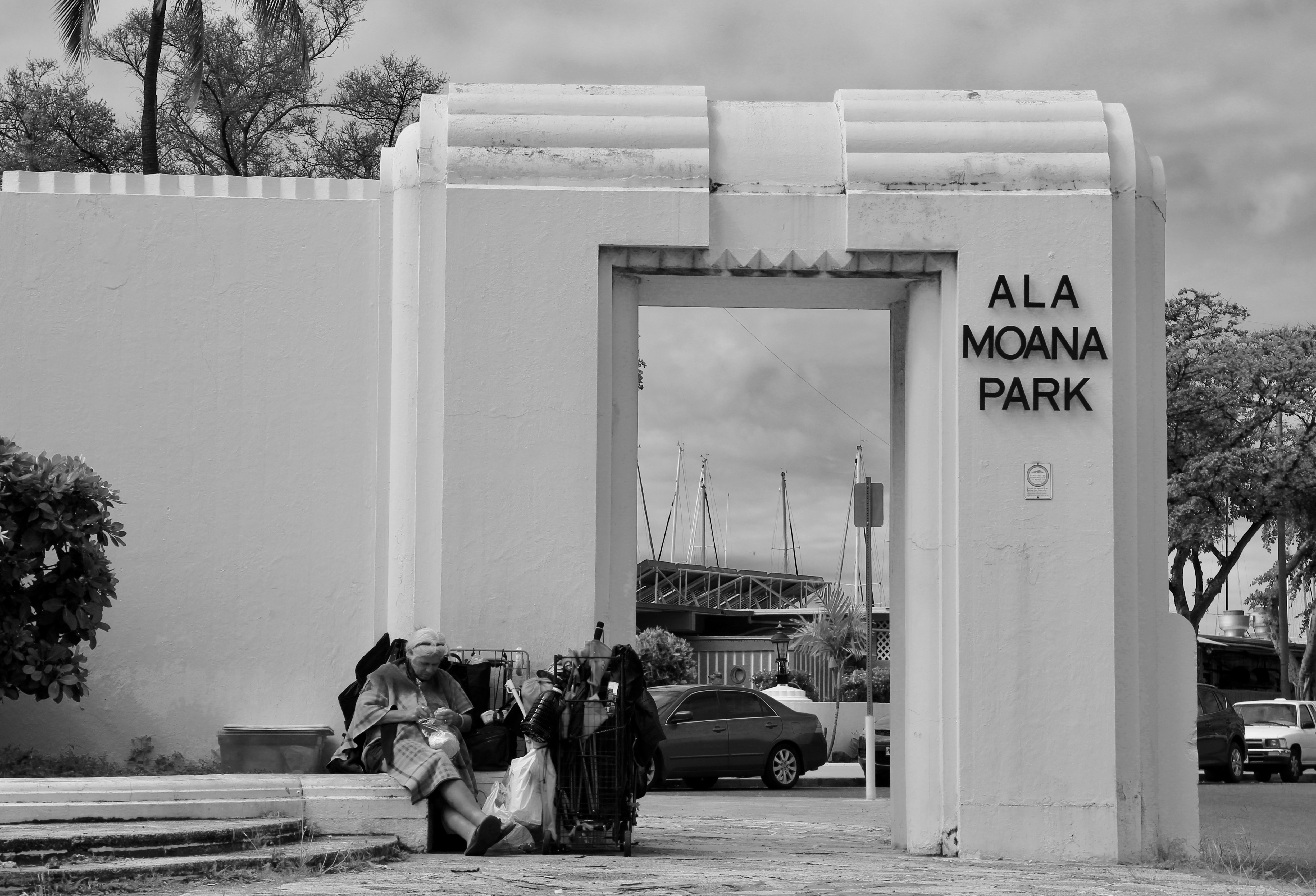I recently went to Honolulu. As is my endless wont when visiting new places, I walked around in near a boutique hotel to see if I could find interesting buildings, pick up Japanese stationery, and otherwise look around. Here’s some things I saw.
Ala Moana Park Entrance
One of my great joys in travel is when I arrive by foot upon an architectural scene. I’m not a fan of pre-research— I purposefully do not look up details of where I’m going. Instead, I just have a general idea that there will be huge targets. In this instance, I had the Ala Moana Mall, which I knew I wanted to see, and simply let the landscape come upon me.

What a special place.

Later, I found a super-detailed PDF— “Hawaii Modernism Context Study“— with this note:
In the late 1930s, a few harbingers of modernist buildings began to appear in Honolulu. Improvements at the Army’s Schofield Barracks, a WPA project, incorporated Art Deco and utilitarian features that hinted at modernism. The public park at Ala Moana Beach, also a WPA project, incorporated a range of Moderne and Art Deco features, giving it a modern feel. (A few movie theaters and some commercial street fronts also had modernistic qualities that contributed a new feeling to urban areas.) World War II, however, would change Hawaii’s position in the world and infuse it with “national” significance. Military construction was a large part of this transition. Acres of temporary housing, tents and Quonset huts changed the rural character of Hawaii overnight. There were massive fortification projects, an expansion of the airfields and projects of national significance such as the fuel storage tanks at Red Hill.
It contains this brilliant bridge:

And other canal-spans:

Macy’s at Ala Moana Mall
Across the street from the park is the Ala Moana Center.

There, at the Macy’s, I saw some lit soffits. imho architects don’t mess around with soffits enough. Here’s a series of tweets on the topic. This is a classic 1959 car-oriented outdoor mall behemoth that has been successful since the go.
Approaching by foot, entering through a vast two-story parking lot, the first thing I saw was the Macy’s. At first I was struck by the shape of the windows across the top of the building.

These reminded me of the top of the Macy’s in downtown Sacramento.

That, and the militaristic tall yellow brick garrison wall.
But then I took a closer look at the patterns on the little lick of roof hanging over the building. These soffits had intricate natural patterns on them— almost like gargoyles w/o faces.

I looked it up later and found out that this used to be a department store called Liberty House, and it opened here at Ala Moana Center exactly 52 years ago the day I was there— April 6, 1966.

Here’s a 121-page comprehensive history of the Ala Moana Center itself. Incredibly detailed.
Shopping malls are fascinating expressions of culture, and this one is rich— focus on cars, outdoor design, the development of Hawaii (it opened 8 days before Hawaii became a state).
All hail the soffits of @Macys Ala Moana Center.





IBM Building
I kept walking, to get Japanese notebooks (create a destination and hope there is landscape upon walking) and I encountered a massive beauty— Vladimir Ossipoff’s 1962 IBM building:

This is why God gave me a tilt-shift lens:

Hale Koa Hotel
This is a Brutalist military resort genius:
The Hale Koa Hotel, which means House of the Warrior in Hawaiian, is an Armed Forces Recreation Center (AFRC) resort hotel located on Waikiki Beach and owned by the United States Department of Defense. It sits on the southeast corner of Fort DeRussy on the western end of Waikiki in Honolulu. The hotel has more than one million guests every year, all of whom require the United States Uniformed Services Privilege and Identification Card to lodge at the hotel. Though owned by the DOD, the hotel is entirely self-sustaining, and does not receive any government funding.


Uniform balconies and a unique history that tracks the martial nature of the state.

Waikiki Natatorium War Memorial
Later I took a walk along Waikiki and ended up coming upon this memorial that is an “ocean water public swimming pool”. Stunning and neglected. Here’s a good history of the site.

Hawaii State Capital
Wow what a building.

Modernism in its sweeping simplicity and crispness, brutalist in its focus on function, as the bicameral nature of the place is displayed on its sleeves.

Downtown Brutalism
Like most cities in America, there are more brutalist beauties if you search for them in the downtown districts that grew in the 60s and 70s. The framing of these stairs made me happy:

They are at the foot of this complex:

Random beauts
Lastly, here’s a potpourri of interesting edifices.

An industrial building with decorative masonry slots.

A luau stage built on the roof of a hotel.


A tunnel carved into a mountain leading to a war bunker.
Buildings are what you make of them.
